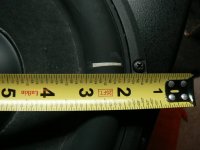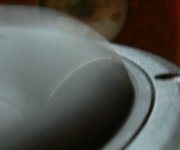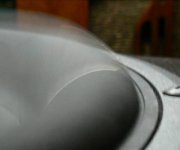Only when the enclosure volume is getting much less than the Vac of the driver will the encolure compliance become more dominant.
John
None of what you say has anything to do with the discussion as I see it. I said that the box compliance linearizes the driver. You commented that this wasn't true because the air compliance is more nonlinear than the driver compliance. (You seem to have backed off from this position now.) You are now backing into simply saying that in extreme cases the air can be "significantly" nonlinear.
My original statement stands and you have done nothing to refute it except to go to extremes where you statement is maginally true.
Let's look at the history. In you post 359 you stated that
Then in post 362 you made the statementthe air spring is linear and a driver in a box is more linear than in free air.
I responded in 363 and concluded thatfor all practical purposes in audio air is always linear.
Drew, in post 366 presented SL's data which showed a comparison of the same driver in free air and a 50L box, undergoing the same excursion, where the box results showed significantly higher distortion. And then you started discussing whether the air is more or less linear than the driver and that the air being more linear will lead to a reduction in distortion which still is in contradiction to the SL data.In the end, when all these affects are summed up the effect of the air spring on reducing inherent driver distortion negligible, even if the air spring is considered linear. The distortion generated by the nonlinearity of the air spring tends to only be significant in sub woofers placed in small enclosures.
As I said in post 363, in the end the degree of distortion reduction, in the region where the air spring may be considered linear, is negligible. The air spring should make a difference only under what you consider extreme conditions and under extreme conditions the air spring becomes nonlinear. I don't necessarily find such conditions extreme for a subwoofer in a small box.
Looking at SL's case (12" XLS in a 50 L box) my sims show the following:
Here the small pink dots are for linear suspension, nonlinear air. Orange dots are for linear air, nonlinear suspension. Blue dots are nonlinear air, nonlinear suspension. What this shows is that if the suspension were perfectly linear the air nonlinearity generates 0.8% 2nd , 0.01% 3rd and higher orders off scale. On the other hand, if the air were perfectly linear we would see only odd order distortion from the suspension, since it is assumed symmetrical, with 3rd order at 10%, 5th at 3.5%, 7th at 1.1%, etc. Finally the blue dots show the result with both nonlinear air and nonlinear suspension. First, note that the odd order distortion is essentially unchanged form the case where the air was assumed linear. That is, there is no effective reduction in suspension related odd order distortion due to making the air spring linear, orange and blue odd order distortion levels are the same. Second, the 2nd order distortion with both nonlinear air and nonlinear suspension is less than the 2nd order distortion when only the air is considered nonlinear. This is perplexing. Why would making the suspension nonlinear reduce 2nd order distortion? I don't know, but that is what the result is. It’s a nonlinear system. Things don’t always behave as expected. Third, correctly accounting for the nonlinearity of air gives rise to higher order distortion of even order. The conclusion is that 1) the air spring, whether assumed linear or correctly considered as nonlinear, doesn't have any significant effect on the driver related odd order distortion, and 2) consideration of air nonlinearity gives rise to even order distortion components which are not dominated by 2nd order.
Now if I drop the excursion to 10% of xmax I find that the air nonlinearity yields about 0.07% 2nd order HD with other components off scale. Suspension related distortion is all off scale. These results remain unchanged when both nonlinearities are included. Surely excursion of 10% Xmax (Xmax=12.5 mm) at 20 Hz in a 50 L box isn't extreme.
These results do not agree well with SL's data, most likely because the major source of nonlinear distortion is from BL nonlinearity. FIY, the compliance ratio is 3 in these sims which means the air spring is nominally 3 times as stiff as the suspension. The problem is that as the excursion increase the suspension compliance increases dramatically so as to protect the driver from over excursion and mechanical damage. i.e, the compliance ratio tends to 0 as Xmax is approached/exceeded. Thus, in the region where the suspension become highly nonlinear the air spring is no longer stiffer than the suspension and it basically plays little roll in controlling the driver motion around Xmax, thus, linear or not, the air can not significantly reduce suspension related distortion as the excursion increases. If protection from over excursion is not provided by the suspension it may be done by using shorted turns at the ends of the VC which generate a very high retarding force. The effect is the same. The forces restraining cone excursion are primarily driver related, not air spring related.
I can also change the shape of the suspension compliance vs. excursion in my sims to increase suspension distortion at lower excursion so that it is significant. When I do this I see insignificant differences in the level of the odd order, suspension related distortion regardless of whether the air spring is linear of nonlinear. All I see is the introduction of even order distortion, even when excursion is 10% of Xmax, though all the distortion remains below 0.1%.
Lastly, all these arguments apply only around resonance and below where the suspension and box compliance generated forces on the driver are of the same order, or greater, than the mass and damping terms. Moving higher in frequency, into the mass dominated region, distortion is mainly a result of BL nonlinearity and the resulting distortion generated in the driving force. Compliance related distortion only appears only as the driver excursion reaches its limits where the suspension compliance decreases to the point so as the restraining force is equal to the driving force, thus preventing the cone from flying out of the box.
John
The point about the air only affecting the even orders is significant. The lack of agreement between your results and Linkwitz is a concern. And I agree about the effect only being significant at and below resonance.
This
Adding a suspension nonlinearity that is purely symmetrical and having it lower a nonsymmetrical order is very suspicious. That you cannot expalin this is also disturbing. I could not comment more without doing my own simulations to confirm or refute your data, which isn't exactly all that clear as I said, and I simply do not have the time to do that. But your analysis just does not jib with my experience.
The point about the air only affecting the even orders is significant. The lack of agreement between your results and Linkwitz is a concern. And I agree about the effect only being significant at and below resonance.
This
seems wrong to me and I can't tell from your data either way.consideration of air nonlinearity gives rise to even order distortion components which are not dominated by 2nd order
Adding a suspension nonlinearity that is purely symmetrical and having it lower a nonsymmetrical order is very suspicious. That you cannot expalin this is also disturbing. I could not comment more without doing my own simulations to confirm or refute your data, which isn't exactly all that clear as I said, and I simply do not have the time to do that. But your analysis just does not jib with my experience.
When I posted the results above I forgot to add the data points for the case where the driver was in free air, with the same excursion. I have appended the figure so now there are small black symbols on it as well. The black dots represent the odd order distortion for the driver in free air. You can see that in all cases the odd order distortion in free air is slightly less than when the driver is in the box, with either the air spring linear or nonlinear.
Earl, that I can't explain the results doesn't mean they are incorrect. Its a nonlinear system and the results can behave in strange ways. Perhaps I could argue that the suspension stiffness increases the over all stiffness thus reducing the distortion from the air spring, which apparently affects the 2nd order distortion in a good way.
Earl, that I can't explain the results doesn't mean they are incorrect. Its a nonlinear system and the results can behave in strange ways. Perhaps I could argue that the suspension stiffness increases the over all stiffness thus reducing the distortion from the air spring, which apparently affects the 2nd order distortion in a good way.

Earl, that I can't explain the results doesn't mean they are incorrect.
I wasn't saying that, I was only saying that what you claim the results say does not seem correct to me. It could be, I don't know. The problem is that I don't have the time to pursue this any further.
I will agree that the whole discussion is kind of academic since its not a significant factor in any case. I mentioned it in passing because thats what I have seen and the "theory" supports it - at least some of it. You've done more on this than I have so I'll have to accept yours for now. That said, its always a good idea to get confirmation of results no matter who does them. Nonlinear modeling can be very tricky.
Hi John and Earl,
Could we perhaps see the effect of the air spring reducing distortion when the driver compliance is off-center by some amount? In this case, in the driver compliance, the area around zero excursion would be on a slope and thus induce non-linearity already at small excursions. If the air spring was now sufficently stiff it could make the total compliance much flatter without the issue of the compliance ratio falling too much at large excursions and without significant non-linearity of the air.
Distortion at lower SPL is arguably more important than at the extremes, no? I would think wiggles in the input-output transfer function that are located at the zero crossing are more objectionable than gently sloping compression at the higher amplitudes. At least this is my impression arising from Earl's work in perception of non-linearities and the usual objection to crossover distortion in amplifiers.
Could we perhaps see the effect of the air spring reducing distortion when the driver compliance is off-center by some amount? In this case, in the driver compliance, the area around zero excursion would be on a slope and thus induce non-linearity already at small excursions. If the air spring was now sufficently stiff it could make the total compliance much flatter without the issue of the compliance ratio falling too much at large excursions and without significant non-linearity of the air.
Distortion at lower SPL is arguably more important than at the extremes, no? I would think wiggles in the input-output transfer function that are located at the zero crossing are more objectionable than gently sloping compression at the higher amplitudes. At least this is my impression arising from Earl's work in perception of non-linearities and the usual objection to crossover distortion in amplifiers.
Cone flexure. If you're going to look at sub .1% response components at moderate drive you may as well thank air for being such a friend and figure out a way to apply a static preload to the cone to restore a more second order nature.
At 5 or maybe even 10% power it might be possible to force a static pressure or vacuum in a sealed enclosure and drive an offset current into the woofer to zero the dislacement. This might help to show off where a lot of odd order response isn't coming from.
At 5 or maybe even 10% power it might be possible to force a static pressure or vacuum in a sealed enclosure and drive an offset current into the woofer to zero the dislacement. This might help to show off where a lot of odd order response isn't coming from.
Last edited:
I don't remember if you mentioned it or not, but what is the Vas of the driver compared to the enclosure volume in your calculations?When I posted the results above I forgot to add the data points for the case where the driver was in free air, with the same excursion. I have appended the figure so now there are small black symbols on it as well. The black dots represent the odd order distortion for the driver in free air. You can see that in all cases the odd order distortion in free air is slightly less than when the driver is in the box, with either the air spring linear or nonlinear.
Earl, that I can't explain the results doesn't mean they are incorrect. Its a nonlinear system and the results can behave in strange ways. Perhaps I could argue that the suspension stiffness increases the over all stiffness thus reducing the distortion from the air spring, which apparently affects the 2nd order distortion in a good way.
I don't remember if you mentioned it or not, but what is the Vas of the driver compared to the enclosure volume in your calculations?
For the latest ones (post 422) Vas was around 137 L. The previous ones were hypothetical and I set the enclosure volume to raise the distortion levels to be comparble to the measured results os Linkwitz. Probably not all that realistic, but the trends are the same in both cases.
On pages 31 and 32 John K posted simulations to show that Thermal Compression is not really a short-term issue and thus repudiated what Gedlee always says. Unlike the other posts of John K's in which he questioned the short-term dynamic behavior of TC, Gedlee did not respond to John K's posts of January 12th.
Mr. Geddes, does this mean you agree? I am very curious as to how serious the problem is or is not, because in my current dipole loudspeaker I am abusing a 7" midwoofer to go sufficiently low in an unbaffled configuration by applying quite a lot of boost.
Mr. Geddes, does this mean you agree? I am very curious as to how serious the problem is or is not, because in my current dipole loudspeaker I am abusing a 7" midwoofer to go sufficiently low in an unbaffled configuration by applying quite a lot of boost.
On pages 31 and 32 John K posted simulations to show that Thermal Compression is not really a short-term issue and thus repudiated what Gedlee always says. Unlike the other posts of John K's in which he questioned the short-term dynamic behavior of TC, Gedlee did not respond to John K's posts of January 12th.
Mr. Geddes, does this mean you agree? I am very curious as to how serious the problem is or is not, because in my current dipole loudspeaker I am abusing a 7" midwoofer to go sufficiently low in an unbaffled configuration by applying quite a lot of boost.
No, silence does not mean that I agree, I am just not in a position to dispute it. I continue to believe that John was not looking at the right things and that he was perdisposed NOT to find anything and didn't. His analysis did not look at the actual modification of a waveform, only the changes in Re over a longer time period than that of the waveform. I would not expect to see anything in that case either, but its not what I would have looked at. Obviously the only way to dispute what he did is to do it the way that I suggested, but I simply do not have the time for that.
Let's say that John is correct - then that still leaves a big hole in our understanding of what constitutes "dynamics". It seems generally agreed that there is some subjective effect in this regard and that it is different among different speakers. If it is not thermal, then what is it? I have operated on the assumption that it is, and I continually get kudos for the "dynamics" of my designs. Maybe its luck and it is something else, but in either case I'm not about to change what I am doing.
I think the important point is the measured distortion for the same driver at the same excursion increases significantly when you put it in a small sealed enclosure. 2nd harmonic nearly doubles to 18% and 3rd harmonic nearly triples to 25%. The 7th and 8th go from under .1% to over 1%.
Now you may say that's inaudible but there is no question that the air spring contributes considerable distortion to real drivers in the real world so its effect is clearly not linear. It may be because of the extra power required but the result, not the reason, is the important thing for a system designer. Even if you don't notice the distortion as such, it will still help you locate the sub and that's a bad thing.
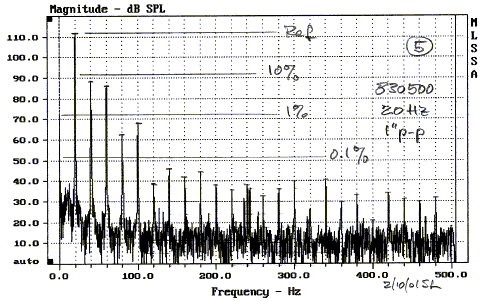
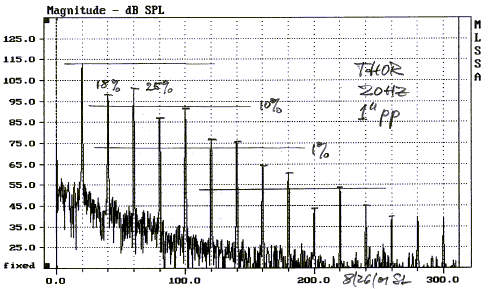
I repeated the linkwitz distortion measurements on my Peerless XLS 12" driver. With a 1" stroke @ 20Hz I saw essentially the same behavior:
When put in a smallish sealed box, the 2nd order distortion doubled, 3rd order tripled.
In car audio, large woofers are often put in very small boxes and then driven at high power. If the surrounds and cones aren't stiff enough, bad sounding things happen. In some cases I have even seen (with the help of a strobe-light) the surround invert on a cycle by cycle basis; cone goes up-surround gets sucked down, cone goes down-surround gets blown up. You can also often see(with strobe-light) the edges of the paper and thin plastic cones flexing away from the direction of cone motion.
I got the idea that perhaps a large portion of the distortion increase with the 12" XLS woofer can be attributed to this type of behavior.
That is, the majority of the distortion increase is coming from the internal box pressure flexing the edge of the cone and distorting the rather large surround. As you can see in the first image, the surround is 1" wide. The cone diameter inside the surround is 9". So, the area of the surround is nearly 50% of the area of the cone. Any nonlinear movements of the surround caused by internal pressure does have considerable radiating area. The cone is a rather soft pulp and not particularly stiff at the edges where it attaches to the surround.
Using a strobe-light I was able to see minor flexing of the cone edge at the peaks of the 1" stroke. It was also evident that the shape of the surround was different depending on whether the woofer was stroking in free air or in an a closed box. In particular, at the peak of the outward motion, the outer third of the surround was flattened, if not slightly concave as the internal pressure is acting to suck it inward. Also, at the peak of the downward motion, the inner third of the surround is noticeably puffed out when in the box while in free air it is pulled basically straight down to the cone edge.
I had no luck getting pics or video of the strobe-light motion. But, I did attach a thin piece of masking tape to the surround to try and highlight the differences I was seeing. The pics aren't the best, but you can get any idea of what I was seeing.
The 1st pic shows the dimensions of the surround and the masking tape stripe.
The 2nd pic is the woofer stroking 1" peak-to-peak in free air
The 3rd pic is the woofer stroking 1" peak-to-peak in sealed box.
Soooo...what to you guys think?
Is this a likely explanation for a major contributor to the rather large rise in distortion when the 12" woofer is placed in a smallish sealed box?
Attachments
Could you not manually displace the diaphragm in the closed box (inward, anyway) and see the same surround change?In car audio, large woofers are often put in very small boxes and then driven at high power. If the surrounds and cones aren't stiff enough, bad sounding things happen. In some cases I have even seen (with the help of a strobe-light) the surround invert on a cycle by cycle basis; cone goes up-surround gets sucked down, cone goes down-surround gets blown up. You can also often see(with strobe-light) the edges of the paper and thin plastic cones flexing away from the direction of cone motion.
Seems to me that you could confirm it this way unless the surround is itself resonating in some fashion at the test frequency that somehow varies under the different loadings.
Dave
Could you not manually displace the diaphragm in the closed box (inward, anyway) and see the same surround change?
Seems to me that you could confirm it this way unless the surround is itself resonating in some fashion at the test frequency that somehow varies under the different loadings.
Dave
Yes, it is easy to see that when you quickly push the driver in 1/2" and hold it, the surround puffs out slightly just like in the pic, and then slowly relaxes and changes shape over the next 5 seconds or so. I know the internal pressure is causing the surround to distort, I'm not trying to confirm that. You are right though....there may also be some type of resonant behavior.
What I'm wondering about, is how to quantify the resulting amount of 2nd and 3rd acoustic distortion. Is this the major cause of the doubling and tripling of distortion? or just a minor contributor.
Steve
I don't think many drivers remain truly pistonic at 1" p-p excursion. I haven't done any benchmarks myself but have seen a couple of my sub. It seems to get low distortion in a sealed box. But the box is built like a tank - ultra-thick curved walls internally braced and weighs around 70 pounds. The driver is also a trilam composite woven driver woven glass and woven carbon. With an amp that has an adequate damping factor.
Yes, we did discuss this long ago and Michael concluded that it was a non-issue, which I never did accept, but it died and I just let it. I never agreed with the conclusions of that thread. As you well know, sometimes you just have to let people walk away thinking the wrong thing sincegets tiring.
.
LOL
If you find it boring that I brought up the issue – corrected a bunch of misconcepts of a bunch of people (yours included) – did a perfect description of sorted out and linked effects *from scratch* – gave even quantitave numbers backed up by measurements – and finally set up a simulation tool to calculate *any* thermal distortion by plugging in a few easy to capture variables -
SO BE IT !

Also *if* you'd read closely – you might have noticed that *I* didn't exactly „conclude it's a non-issue“ - just dindn't want to make too big of a fuss of it...
🙂
Michael
Last edited:
Thanks guys !
Arrived at post 300 finally, I see you still struggling with mis-concepts that I've clarified and outlined two years ago - I mean - to look at thermal behaviour of speakers and trying to draw conclusions without looking at cooling, to me is like trying to decipher a circuit without knowing about voltage *and* current.
Another 100 or so postings left - I expect having a weekend of amusement.
😉
Michael
Arrived at post 300 finally, I see you still struggling with mis-concepts that I've clarified and outlined two years ago - I mean - to look at thermal behaviour of speakers and trying to draw conclusions without looking at cooling, to me is like trying to decipher a circuit without knowing about voltage *and* current.
Another 100 or so postings left - I expect having a weekend of amusement.
😉
Michael
Last edited:
It still was fun - but even more so a pleasure too, past #300 - I frankly have to admit !
---------
The agenda is in the headline :
http://www.diyaudio.com/forums/mult...thermal-distortion-developing-point-view.html
You can also jump into Lynn's thread about the time of starting - to dig even deeper into how this all evolved - just in case of...
Michael
---------
Michael, do you have a link (or title) to that other thread? Would be much appreciated!
The agenda is in the headline :
http://www.diyaudio.com/forums/mult...thermal-distortion-developing-point-view.html
You can also jump into Lynn's thread about the time of starting - to dig even deeper into how this all evolved - just in case of...
Michael
Last edited:
- Status
- Not open for further replies.
- Home
- Loudspeakers
- Multi-Way
- Question for Geddes and John K
